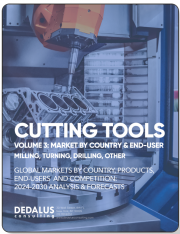
|
시장보고서
상품코드
1804428
세계의 DIY 툴 시장 : 제품 유형, 동력원, 용도, 최종사용자, 유통 채널별 - 세계 예측(2025-2030년)DIY Tools Market by Product Type, Power Source, Application, End User, Distribution Channel - Global Forecast 2025-2030 |
||||||
DIY 툴 시장의 2024년 시장 규모는 7억 2,923만 달러로 평가되었습니다. 2025년에는 7억 7,445만 달러로 성장하여 CAGR은 6.48%, 2030년에는 10억 6,327만 달러에 이를 것으로 예측됩니다.
| 주요 시장 통계 | |
|---|---|
| 기준 연도 : 2024년 | 7억 2,923만 달러 |
| 추정 연도 : 2025년 | 7억 7,445만 달러 |
| 예측 연도 : 2030년 | 10억 6,327만 달러 |
| CAGR(%) | 6.48% |
경쟁 환경을 형성하는 기본 촉진요인, 새로운 트렌드, 전략적 기회를 통해 DIY 공구 분야의 부흥을 그립니다.
DIY 공구 시장은 최종 사용자가 점점 더 실용적인 주택 개량 및 전문 유지 보수 프로젝트를 받아들이면서 눈에 띄게 발전하고 있습니다. 독립 장인부터 주말 주택 소유자까지, 다재다능하고 신뢰할 수 있으며 사용하기 쉬운 도구에 대한 수요는 계속 증가하고 있습니다. 이러한 열정 증가는 인구 통계학적 변화, 가정 내 해결책을 선호하는 도시 생활의 제약, 자급자족에 대한 문화적 축의 수렴에 의해 뒷받침되고 있습니다. 따라서 DIY 툴 분야는 혼잡한 시장에서 혁신과 차별화를 추구하는 제조업체의 초점이 되고 있습니다.
기술 혁신, 소비자 행동, 공급망의 진화를 통해 DIY 툴의 판도를 바꿀 수 있는 매우 중요한 변혁적 전환을 밝힙니다.
DIY 공구 산업의 정세는 제품 개선에 그치지 않고 일련의 변혁적 변화를 통해 재편되고 있습니다. 가장 대표적인 것이 임베디드 센서, 무선 연결, 모바일 앱 통합과 같은 디지털 기술의 도입입니다. 이러한 기술 혁신은 사전 예방적 유지보수 알림, 성능 분석, 원격 문제 해결을 가능하게 하여 사용자 경험을 향상시키고 애프터마켓 서비스의 새로운 길을 열고 있습니다.
2025년 미국 관세가 DIY 부문 전체 국내 생산, 수입 동향, 가격 전략, 공급망 구조에 미치는 종합적인 영향에 대한 종합 평가
미국이 2025년에 시행하는 관세의 누적 영향은 DIY 공구 생산 및 수입 채널에 파문을 일으키고 있습니다. 그동안 수입 부품에 크게 의존하던 국내 제조업체들은 조달 모델을 재검토하고 일부 사업의 리쇼어링을 검토할 수밖에 없게 되었습니다. 이러한 재조정은 적시 납품이라는 고객의 기대에 부응하면서도 안정적인 이윤을 유지하기 위해 노력하는 주요 기업들의 현지 생산 능력에 대한 재투자로 이어지고 있습니다.
제품 유형, 전원 공급 장치, 용도, 최종 사용자, 유통 채널을 통합하여 부문 수준의 관점을 파악하여 타겟팅된 통찰력과 성장 요인을 파악할 수 있습니다.
시장 세분화에 대한 미묘한 이해는 제품 개발 및 마케팅 이니셔티브를 조정하는 데 매우 중요합니다. 제품 유형별로 분류하면 액세서리, 정원용 공구, 수공구, 전동공구, 전동공구 각각에 고유한 비즈니스 기회가 있음을 알 수 있습니다. 액세서리 중에서는 무선 용도이 대중화되고 사용자가 더 높은 내구성을 요구함에 따라 배터리, 비트, 블레이드, 충전기가 차별화의 초점으로 부상하고 있습니다. 정원용 톱, 잔디깎기기계, 삽, 트리머와 같은 정원 도구는 저공해 야외 장비로의 소비자 이동을 반영하여 인체공학적 개선과 전동화의 혜택을 계속 누리고 있습니다.
시장 성장 촉진요인과 경쟁 구도를 파악하기 위해 북미, 남미, 유럽, 중동 및 아프리카, 아시아태평양의 역학을 조사하여 지역적 뉘앙스를 탐색합니다.
지역적 역동성은 업계 참여자들의 전략적 우선순위를 형성하는 데 있어 매우 중요한 역할을 하고 있습니다. 북미와 남미에서는 혁신 문화와 주택 개조에 대한 높은 소비 지출을 배경으로 첨단 배터리 기술 및 커넥티드 툴 생태계에 중점을 두고 있습니다. 또한, 주거 및 상업 부문의 인프라 개선 이니셔티브는 견고하고 에너지 효율적인 장비에 대한 지속적인 수요를 창출하고 있습니다.
DIY 툴 시장의 핵심 역량, 전략적 이니셔티브, R&D 초점, 파트너십 생태계에 대한 심층적인 기업 통찰력별 주요 기업 프로파일을 공개합니다.
DIY 공구 분야의 주요 기업들은 기술 리더십, 전략적 파트너십, 브랜드 자산의 조합을 통해 차별화를 꾀하고 있습니다. 한 선도기업은 심층적인 연구개발 능력을 활용하여 구동시간 연장 및 급속 충전 사이클을 실현하는 첨단 배터리 화학물질을 개발했습니다. 이 혁신은 재료 전문가 및 학술 기관과의 협력 네트워크를 통해 강화되었습니다. 또한, 디지털 플랫폼에 중점을 두고 IoT 지원 도구와 예지보전, 펌웨어 업데이트, 성능 분석 등을 포함한 종합적인 서비스 생태계를 통합하고 있습니다.
업계 리더들이 새로운 트렌드를 활용하고, 위험을 줄이고, DIY 툴의 지속 가능한 성장을 가속할 수 있는 실행 가능한 전략과 권장 사항을 수립할 수 있도록 지원
진화하는 DIY 툴의 상황을 극복하기 위해 업계 리더는 디지털 기능에 대한 전략적 투자를 우선시해야 합니다. 클라우드 기반 플랫폼과 분석 툴을 도입함으로써 기업은 사용 데이터를 활용하고, 유지보수 수요를 예측하고, 개인화된 서비스를 제공할 수 있게 됩니다. 동시에, 니어쇼어링과 다단계 조달 계약을 통해 공급망 발자국을 다양화함으로써 지정학적 변화와 정책 변화에 대한 노출을 줄일 수 있습니다. 유연한 조달 모델을 구축함으로써 기업은 비용 변동에 신속하게 대응하고 중단 없는 생산을 보장할 수 있습니다.
데이터의 무결성을 보장하고 종합적인 시장 인사이트을 제공하기 위해 정량적 접근과 정성적 접근을 통합한 강력한 조사 방법을 상세하게 설명합니다.
본 분석을 뒷받침하는 조사 방법은 종합적인 포괄성과 데이터의 완전성을 보장하기 위해 정량적 접근과 정성적 접근을 모두 통합하고 있습니다. 첫 번째 2차 조사는 거시경제 요인, 기술 궤적, 정책 환경에 대한 기초적인 이해를 확립하기 위해 업계 간행물, 기술 표준, 특허 출원, 규제 문서 검토로 구성되었습니다. 또한, 시장 진출기업의 전략적 의도를 파악하기 위해 기업의 정보공개, 연차보고서, 보도자료를 체계적으로 분석하였습니다.
DIY 툴 시장의 이해 관계자를 위해 통찰력을 통합하고 주요 하이라이트를 강화하고 미래의 경로를 명확히하는 전략적 전망으로 마무리합니다.
결론적으로 DIY 공구 분야는 기술의 진화, 소비자의 기대치 변화, 정책적 파괴에 의해 정의되는 교차로에 위치하고 있습니다. 스마트 기능과 지속 가능한 설계 원칙의 통합은 제품 성능의 새로운 벤치마크를 설정하고 있습니다. 동시에 지역적 역동성과 관세에 대한 고려가 공급망 전략을 재구성하고 있으며, 기업들은 더 높은 민첩성과 투명성을 요구하고 있습니다.
목차
제1장 서문
제2장 조사 방법
제3장 주요 요약
제4장 시장 개요
제5장 시장 역학
제6장 시장 인사이트
- Porter's Five Forces 분석
- PESTEL 분석
제7장 미국 관세의 누적 영향 2025
제8장 DIY 툴 시장 : 제품 유형별
- 액세서리
- 배터리
- 비트
- 블레이드
- 챠쟈즈
- 가든 툴
- 가든 소
- 잔디깎기기계
- 삽
- 트리머
- 수공도구
- 해머
- 펜찌
- 운전자
- 렌치
- 전동 공구
제9장 DIY 툴 시장 : 동력원별
- 전기
- 매뉴얼
제10장 DIY 툴 시장 : 용도별
- 자동차
- 전기
- 원예
- 금속 가공
- 목공
제11장 DIY 툴 시장 : 최종사용자별
- 상업
- 산업
- 주택
제12장 DIY 툴 시장 : 유통 채널별
- 오프라인 소매
- 온라인 소매
- E-Commerce 플랫폼
- 제조업체 웹사이트
제13장 아메리카의 DIY 툴 시장
- 미국
- 캐나다
- 멕시코
- 브라질
- 아르헨티나
제14장 유럽, 중동 및 아프리카의 DIY 툴 시장
- 영국
- 독일
- 프랑스
- 러시아
- 이탈리아
- 스페인
- 아랍에미리트(UAE)
- 사우디아라비아
- 남아프리카공화국
- 덴마크
- 네덜란드
- 카타르
- 핀란드
- 스웨덴
- 나이지리아
- 이집트
- 튀르키예
- 이스라엘
- 노르웨이
- 폴란드
- 스위스
제15장 아시아태평양의 DIY 툴 시장
- 중국
- 인도
- 일본
- 호주
- 한국
- 인도네시아
- 태국
- 필리핀
- 말레이시아
- 싱가포르
- 베트남
- 대만
제16장 경쟁 구도
- 시장 점유율 분석, 2024
- FPNV 포지셔닝 매트릭스, 2024
- 경쟁 분석
- Wurth Industrie Service GmbH & Co. KG
- OBI Home and Garden GmbH
- AIMCO
- Apex Tool Group, LLC
- Asian Paints Limited
- Atlas Copco AB
- Einhell Germany AG
- Emerson Electric Co.
- Ferm International B.V.
- Festool GmbH
- Hilti AG
- Ingersoll-Rand plc
- Innovative Tools & Technologies, Inc.
- Koki Holdings Co., Ltd.
- Metabo Corporation
- Robert Bosch Power Tools GmbH
- Snap-on Incorporated
- Stanley Black & Decker, Inc.
- URYU SEISAKU, LTD.
제17장 리서치 AI
제18장 리서치 통계
제19장 리서치 컨택트
제20장 리서치 기사
제21장 부록
LSH 25.09.12The DIY Tools Market was valued at USD 729.23 million in 2024 and is projected to grow to USD 774.45 million in 2025, with a CAGR of 6.48%, reaching USD 1,063.27 million by 2030.
| KEY MARKET STATISTICS | |
|---|---|
| Base Year [2024] | USD 729.23 million |
| Estimated Year [2025] | USD 774.45 million |
| Forecast Year [2030] | USD 1,063.27 million |
| CAGR (%) | 6.48% |
Charting the Rise of the DIY Tools Sector Through Foundational Drivers, Emerging Trends, and Strategic Opportunities Shaping the Competitive Environment
The DIY tools market has undergone a remarkable evolution as end users increasingly embrace hands-on home improvement and professional maintenance projects. From independent craftsmen to weekend homeowners, demand for versatile, reliable, and user-friendly tools continues to rise. This growing enthusiasm is underpinned by a convergence of demographic shifts, urban living constraints that favor at-home solutions, and a cultural pivot toward self-sufficiency. As such, the DIY tools sector has become a focal point for manufacturers seeking to innovate and differentiate their offerings in a crowded marketplace.
Against this backdrop, industry participants are recognizing the need to align product development with consumer expectations for seamless experiences. Technological integration, ergonomic design, and smart connectivity features are increasingly viewed as must-haves rather than luxuries. Consequently, market entrants and established players alike are allocating both talent and capital toward next-generation offerings that merge traditional tool reliability with digital enhancements. In turn, this strategic focus is reshaping competitive dynamics and raising the bar for performance standards.
In essence, the starting point for any strategic planning within this space is a clear understanding of evolving customer needs, shifting purchasing behaviors, and the key external drivers that set the stage for growth. This introduction lays the groundwork for a deeper examination of the transformative forces, tariff effects, segmentation nuances, and regional particularities that define today's DIY tools environment.
Unveiling the Pivotal Transformative Shifts Altering the Landscape of DIY Tools Through Technological Innovation, Consumer Behavior, and Supply Chain Evolution
The landscape of the DIY tools industry is being reshaped by a series of transformative shifts that extend beyond incremental product improvements. Foremost among these is the infusion of digital technologies such as embedded sensors, wireless connectivity, and mobile app integrations. These innovations are enabling proactive maintenance alerts, performance analytics, and remote troubleshooting, thereby elevating the user experience and unlocking new pathways for aftermarket services.
Simultaneously, consumer behavior is adjusting in response to broader societal trends. The rise of experiential retail and immersive showroom formats is prompting manufacturers to revise their distribution strategies, emphasizing hands-on demonstrations coupled with digital touchpoints. At the same time, environmental stewardship has become a critical lens through which product lifecycles are evaluated. Sustainable materials, energy-efficient power sources, and circular economy initiatives are rapidly migrating from peripheral considerations to core design criteria.
Moreover, supply chain resilience has moved to the forefront of strategic planning. The imperative to diversify sourcing strategies, enhance inventory visibility, and leverage real-time logistics tracking tools has never been more pronounced. In this evolving context, stakeholders must anticipate how these converging forces-digital evolution, shifting consumer values, and supply chain optimization-will coalesce to determine winners and laggards in the coming decade.
Evaluating the Comprehensive Impact of United States Tariffs in 2025 on Domestic Production, Import Dynamics, Pricing Strategies, and Supply Chain Structures Across the DIY Segment
The cumulative impact of tariffs implemented by the United States in 2025 has sent ripples across production and import channels for DIY tools. Domestic manufacturers that previously relied heavily on imported components have been compelled to reexamine sourcing models and consider reshoring select operations. This recalibration has led to renewed investments in local production capabilities as companies strive to maintain margin stability while fulfilling customer expectations for timely delivery.
Concurrently, import dynamics have been recalibrated to account for elevated duties on key raw materials and finished products. Forward-thinking organizations have responded by renegotiating contracts, seeking alternative supplier relationships in tariff-exempt markets, and optimizing product portfolios to emphasize higher-margin, tariff-resilient categories. As a result, pricing strategies have become increasingly granular, with cost-plus approaches supplemented by value-based pricing frameworks that account for brand positioning and unique product features.
In the longer term, these tariff implications are catalyzing broader discussions around supply chain transparency and risk mitigation. Companies are exploring advanced analytics to forecast cost volatility, adopting modular design principles to enable component substitution, and enhancing collaboration with logistics partners. Through these efforts, the industry is forging a more resilient foundation capable of withstanding policy-driven disruptions.
Unlocking Segment-Level Perspectives by Integrating Product Type, Power Source, Application, End User, and Distribution Channel to Reveal Targeted Insights and Growth Enablers
A nuanced understanding of market segments is crucial for tailoring product development and marketing initiatives. Segmentation by product type reveals that accessories, garden tools, hand tools, and power tools each present unique opportunities. Within accessories, batteries, bits, blades, and chargers are emerging as focal areas for differentiation, as cordless applications proliferate and users demand higher durability. Garden tools such as garden saws, lawnmowers, shovels, and trimmers continue to benefit from ergonomic enhancements and electrification, reflecting a consumer shift toward low-emission outdoor equipment.
Power source segmentation underscores the coexistence of electric and manual offerings. The rise of electric models has spurred investment in battery technology and motor efficiency, while manual tools retain appeal in contexts where portability, precision, and cost-effectiveness are paramount. Application segmentation further refines targeting by highlighting automotive, electrical, gardening, metalworking, and woodworking use cases. Each application category demands specialized features, from torque optimization for metalworking to dust management for woodworking tasks.
End user segmentation delineates commercial, industrial, and residential channels, illustrating how usage patterns and purchase drivers diverge across professional contractors, manufacturing settings, and DIY enthusiasts. Lastly, distribution channel insights demonstrate the growing significance of both offline retail environments and online retail ecosystems. Within digital channels, traditional e-commerce platforms are complemented by manufacturer websites, enabling brands to establish direct-to-consumer relationships and capture richer customer data.
Navigating Regional Nuances by Examining the Americas, Europe Middle East and Africa, and Asia Pacific Dynamics to Illuminate Market Drivers and Competitive Landscape
Regional dynamics play a pivotal role in shaping strategic priorities for industry participants. In the Americas, there is a pronounced emphasis on advanced battery technologies and connected tool ecosystems, driven by a culture of innovation and high consumer spending on home improvement. Furthermore, infrastructure renovation initiatives across residential and commercial sectors are creating sustained demand for robust, energy-efficient equipment.
Europe, the Middle East, and Africa exhibit a heightened focus on regulatory compliance and environmental impact. Stricter emissions guidelines and eco-design standards have prompted manufacturers to accelerate the development of low-emission alternatives and biodegradable materials. At the same time, urbanization trends in key African markets are opening new pathways for compact, multi-functional tools that address space constraints.
Asia-Pacific remains an engine of growth, supported by expanding middle classes, rising digital adoption, and the popularity of maker communities. In countries with strong manufacturing ecosystems, localized production hubs are reducing lead times and fostering rapid innovation cycles. Meanwhile, cross-border e-commerce is enabling emerging brands to access global audiences with minimal distribution friction. These regional nuances underscore the need for adaptive strategies that resonate with local dynamics while leveraging global best practices.
Profiling Leading Players with In-Depth Company Insights to Highlight Core Competencies, Strategic Initiatives, R&D Focus, and Partnership Ecosystems Within the DIY Tools Market
Leading companies in the DIY tools sector are distinguishing themselves through a combination of technological leadership, strategic partnerships, and brand equity. One prominent player has leveraged its deep R&D capabilities to pioneer advanced battery chemistries that deliver extended runtimes and rapid charging cycles. This innovation has been reinforced by a network of collaborations with materials specialists and academic institutions. Another market stalwart has focused on digital platforms, integrating IoT-enabled tools with comprehensive service ecosystems that include predictive maintenance, firmware updates, and performance analytics.
Simultaneously, established manufacturers are expanding their product portfolios through targeted acquisitions, thereby accessing complementary technologies and distribution networks. In parallel, emerging entrants are capitalizing on direct-to-consumer channels to build intimate relationships with end users and gather real-time feedback that informs iterative design enhancements. Across the board, brand narratives emphasize reliability, safety certifications, and post-sales support, reflecting a growing premium on customer trust.
Collectively, these strategic initiatives illustrate how top performers are blending product innovation, ecosystem integration, and customer-centric marketing to fortify their positions. Moving forward, the ability to orchestrate these elements cohesively will serve as a key differentiator in an increasingly competitive landscape.
Formulating Actionable Strategies and Recommendations to Enable Industry Leaders to Capitalize on Emerging Trends, Mitigate Risks, and Drive Sustainable Growth in DIY Tools
To navigate the evolving DIY tools landscape, industry leaders should prioritize strategic investments in digital capabilities. Embracing cloud-based platforms and analytics tools will enable organizations to harness usage data, predict maintenance needs, and deliver personalized service offerings. At the same time, diversifying supply chain footprints through nearshoring and multi-tiered sourcing agreements will mitigate exposure to geopolitical shifts and policy changes. By establishing flexible procurement models, companies can adapt quickly to cost fluctuations and ensure uninterrupted production.
Furthermore, a sustained commitment to sustainability initiatives can unlock both regulatory advantages and brand loyalty. Integrating recycled materials into tool components and optimizing manufacturing processes for energy efficiency will resonate with environmentally conscious consumers. Equally important is the cultivation of strategic partnerships with logistics providers to enhance last-mile delivery capabilities and reduce carbon footprints.
Lastly, organizations should foster a culture of continuous innovation. Establishing cross-functional innovation labs, engaging with maker communities, and leveraging open-innovation platforms can accelerate product development cycles. By aligning these actionable strategies with clear performance metrics, industry leaders can translate insights into tangible outcomes and secure long-term growth in the competitive DIY tools environment.
Detailing a Robust Research Methodology That Integrates Quantitative and Qualitative Approaches to Ensure Data Integrity and Deliver Comprehensive Market Insights
The research methodology underpinning this analysis integrates both quantitative and qualitative approaches to ensure comprehensive coverage and data integrity. Initial secondary research comprised a review of industry publications, technical standards, patent filings, and regulatory documents to establish a foundational understanding of macroeconomic factors, technological trajectories, and policy environments. This was complemented by a systematic analysis of corporate disclosures, annual reports, and press releases to capture the strategic intentions of leading market participants.
Primary research was conducted through in-depth interviews with senior executives, product managers, procurement specialists, and channel partners. These dialogues provided nuanced insights into supply chain constraints, product innovation pipelines, and distribution strategies. The qualitative findings were then cross-validated through structured surveys distributed to end-user segments, including professional contractors and DIY enthusiasts, to gauge usage behavior and purchase considerations.
To enhance analytical rigor, data triangulation techniques were employed, reconciling disparate sources and identifying discrepancies. Advanced statistical tools were utilized to detect trend patterns and refine thematic categorizations. Finally, the assembled intelligence was subjected to multi-tiered validation by subject-matter experts to ensure accuracy and relevance before synthesizing the insights into this comprehensive narrative.
Concluding with Strategic Perspectives That Synthesize Insights, Reinforce Key Findings, and Highlight Future Pathways for Stakeholders in the DIY Tools Market
In conclusion, the DIY tools sector is poised at a crossroads defined by technological evolution, shifting consumer expectations, and policy-driven disruptions. The integration of smart features and sustainable design principles is setting new benchmarks for product performance. Concurrently, regional dynamics and tariff considerations are reshaping supply chain strategies, prompting companies to seek greater agility and transparency.
Segmentation analysis illuminates the diverse requirements across product types, power sources, applications, end users, and distribution channels, underlining the importance of targeted approaches. Leading organizations are demonstrating how unified investment in R&D, digital ecosystems, and strategic alliances can yield competitive advantage. Yet, the path forward demands continual adaptation to maintain relevance.
Stakeholders who leverage these insights to refine sourcing models, enhance customer-centric offerings, and cultivate innovation cultures will be best positioned to capture emerging opportunities. As the DIY tools market continues to evolve, sustained commitment to strategic foresight and operational excellence will determine the leaders of tomorrow.
Table of Contents
1. Preface
- 1.1. Objectives of the Study
- 1.2. Market Segmentation & Coverage
- 1.3. Years Considered for the Study
- 1.4. Currency & Pricing
- 1.5. Language
- 1.6. Stakeholders
2. Research Methodology
- 2.1. Define: Research Objective
- 2.2. Determine: Research Design
- 2.3. Prepare: Research Instrument
- 2.4. Collect: Data Source
- 2.5. Analyze: Data Interpretation
- 2.6. Formulate: Data Verification
- 2.7. Publish: Research Report
- 2.8. Repeat: Report Update
3. Executive Summary
4. Market Overview
- 4.1. Introduction
- 4.2. Market Sizing & Forecasting
5. Market Dynamics
- 5.1. Increasing demand for high-performance cordless battery platforms with rapid charging and extended runtime
- 5.2. Adoption of smart IoT-enabled tool management systems for inventory tracking and predictive maintenance
- 5.3. Integration of augmented reality tutorials and guides directly into power tool interfaces for real-time assistance
- 5.4. Expansion of subscription-based on-demand tool rental platforms for flexible DIY project access
- 5.5. Growth of eco-conscious tool lines focusing on biodegradable plastics and recycled metal components
- 5.6. Integration of AI-powered voice assistance in power tools for hands-free workflow optimization
- 5.7. Emergence of modular multi-tool systems with swappable heads for space-efficient storage and versatility
- 5.8. Development of 3D printing attachments for power drills enabling on-demand fabrication of custom tool accessories
- 5.9. Rise of blockchain-based tool ownership certification platforms to authenticate secondhand equipment provenance
6. Market Insights
- 6.1. Porter's Five Forces Analysis
- 6.2. PESTLE Analysis
7. Cumulative Impact of United States Tariffs 2025
8. DIY Tools Market, by Product Type
- 8.1. Introduction
- 8.2. Accessories
- 8.2.1. Batteries
- 8.2.2. Bits
- 8.2.3. Blades
- 8.2.4. Chargers
- 8.3. Garden Tools
- 8.3.1. Garden Saws
- 8.3.2. Lawnmowers
- 8.3.3. Shovels
- 8.3.4. Trimmers
- 8.4. Hand Tools
- 8.4.1. Hammers
- 8.4.2. Pliers
- 8.4.3. Screwdrivers
- 8.4.4. Wrenches
- 8.5. Power Tools
9. DIY Tools Market, by Power Source
- 9.1. Introduction
- 9.2. Electric
- 9.3. Manual
10. DIY Tools Market, by Application
- 10.1. Introduction
- 10.2. Automotive
- 10.3. Electrical
- 10.4. Gardening
- 10.5. Metalworking
- 10.6. Woodworking
11. DIY Tools Market, by End User
- 11.1. Introduction
- 11.2. Commercial
- 11.3. Industrial
- 11.4. Residential
12. DIY Tools Market, by Distribution Channel
- 12.1. Introduction
- 12.2. Offline Retail
- 12.3. Online Retail
- 12.3.1. E-Commerce Platforms
- 12.3.2. Manufacturer Websites
13. Americas DIY Tools Market
- 13.1. Introduction
- 13.2. United States
- 13.3. Canada
- 13.4. Mexico
- 13.5. Brazil
- 13.6. Argentina
14. Europe, Middle East & Africa DIY Tools Market
- 14.1. Introduction
- 14.2. United Kingdom
- 14.3. Germany
- 14.4. France
- 14.5. Russia
- 14.6. Italy
- 14.7. Spain
- 14.8. United Arab Emirates
- 14.9. Saudi Arabia
- 14.10. South Africa
- 14.11. Denmark
- 14.12. Netherlands
- 14.13. Qatar
- 14.14. Finland
- 14.15. Sweden
- 14.16. Nigeria
- 14.17. Egypt
- 14.18. Turkey
- 14.19. Israel
- 14.20. Norway
- 14.21. Poland
- 14.22. Switzerland
15. Asia-Pacific DIY Tools Market
- 15.1. Introduction
- 15.2. China
- 15.3. India
- 15.4. Japan
- 15.5. Australia
- 15.6. South Korea
- 15.7. Indonesia
- 15.8. Thailand
- 15.9. Philippines
- 15.10. Malaysia
- 15.11. Singapore
- 15.12. Vietnam
- 15.13. Taiwan
16. Competitive Landscape
- 16.1. Market Share Analysis, 2024
- 16.2. FPNV Positioning Matrix, 2024
- 16.3. Competitive Analysis
- 16.3.1. Wurth Industrie Service GmbH & Co. KG
- 16.3.2. OBI Home and Garden GmbH
- 16.3.3. AIMCO
- 16.3.4. Apex Tool Group, LLC
- 16.3.5. Asian Paints Limited
- 16.3.6. Atlas Copco AB
- 16.3.7. Einhell Germany AG
- 16.3.8. Emerson Electric Co.
- 16.3.9. Ferm International B.V.
- 16.3.10. Festool GmbH
- 16.3.11. Hilti AG
- 16.3.12. Ingersoll-Rand plc
- 16.3.13. Innovative Tools & Technologies, Inc.
- 16.3.14. Koki Holdings Co., Ltd.
- 16.3.15. Metabo Corporation
- 16.3.16. Robert Bosch Power Tools GmbH
- 16.3.17. Snap-on Incorporated
- 16.3.18. Stanley Black & Decker, Inc.
- 16.3.19. URYU SEISAKU, LTD.



















